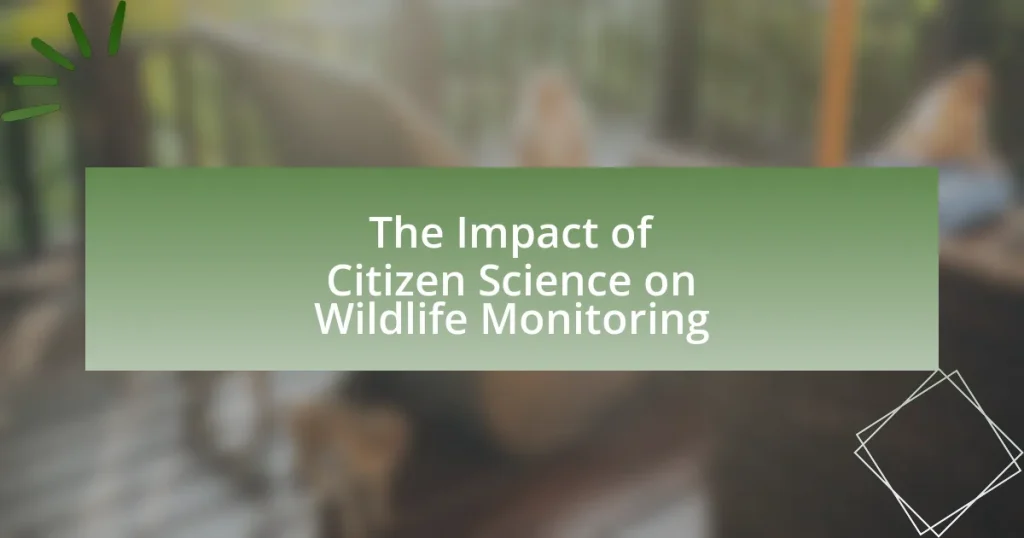Citizen science plays a crucial role in enhancing wildlife monitoring by engaging the public in data collection and research efforts. This collaborative approach allows for the gathering of extensive data across various geographical areas, significantly improving the understanding of species populations and behaviors. The article explores how citizen scientists contribute to wildlife data collection through methods such as observation, photography, and mobile applications, while also addressing the reliability of the data they provide. Additionally, it discusses the challenges faced by citizen science initiatives, the benefits of public involvement in conservation, and successful examples that highlight the effectiveness of these projects in informing wildlife conservation strategies.

What is the impact of citizen science on wildlife monitoring?
Citizen science significantly enhances wildlife monitoring by increasing data collection efforts and expanding research reach. Engaging the public allows for the gathering of large volumes of data across diverse geographical areas, which is crucial for tracking species populations and behaviors. For instance, studies have shown that citizen scientists contributed to over 1.5 million observations in the eBird project, aiding in the understanding of migratory patterns and population trends of birds. This collaborative approach not only enriches scientific knowledge but also fosters community involvement and awareness regarding biodiversity conservation.
How does citizen science contribute to wildlife data collection?
Citizen science significantly contributes to wildlife data collection by engaging non-professionals in systematic observation and reporting of wildlife. This approach expands the volume and geographic coverage of data collected, as thousands of volunteers can monitor species across diverse habitats, often in real-time. For instance, projects like eBird have amassed over 1 billion bird observations from citizen scientists, providing critical data for understanding avian populations and trends. Such extensive datasets enhance the accuracy of wildlife monitoring, enabling researchers to make informed conservation decisions and track changes in biodiversity effectively.
What methods do citizen scientists use to gather wildlife data?
Citizen scientists gather wildlife data using methods such as direct observation, photography, audio recording, and mobile applications. Direct observation involves individuals recording species sightings and behaviors in their natural habitats, often using standardized protocols to ensure data consistency. Photography allows for visual documentation of species, which can be verified by experts for accurate identification. Audio recording captures animal calls and sounds, contributing to understanding species presence and behavior. Mobile applications, like iNaturalist, facilitate data collection by enabling users to upload observations and share them with a broader scientific community, enhancing data accessibility and collaboration. These methods collectively contribute to large-scale wildlife monitoring efforts, providing valuable data for conservation and research initiatives.
How reliable is the data collected by citizen scientists?
The data collected by citizen scientists can be highly reliable, often comparable to that gathered by professional scientists. Studies have shown that citizen science data can achieve accuracy rates of over 90% in certain contexts, such as biodiversity monitoring and species identification. For instance, a study published in the journal “Biological Conservation” by Daniel J. Schneider and colleagues found that data from citizen scientists on bird populations closely matched data from trained ornithologists, demonstrating the potential for citizen science to contribute valuable and reliable information for wildlife monitoring.
What role do citizen scientists play in wildlife conservation?
Citizen scientists play a crucial role in wildlife conservation by collecting data, monitoring species, and contributing to research efforts. Their involvement enhances the scope and scale of conservation projects, as they can gather large amounts of information across diverse geographic areas. For instance, studies have shown that citizen science initiatives, such as the Audubon Society’s Christmas Bird Count, have provided valuable long-term data on bird populations, helping to identify trends and inform conservation strategies. This collaborative approach not only increases public engagement in conservation but also aids scientists in making data-driven decisions to protect wildlife effectively.
How do citizen scientists assist in tracking endangered species?
Citizen scientists assist in tracking endangered species by collecting data on species sightings, behaviors, and habitats. They contribute to large-scale monitoring efforts through platforms like iNaturalist and eBird, where they report observations that help researchers identify population trends and distribution patterns. For example, a study published in the journal “Biological Conservation” found that citizen-collected data significantly improved the accuracy of species distribution models, demonstrating the value of public involvement in conservation efforts.
What are the benefits of involving the public in wildlife conservation efforts?
Involving the public in wildlife conservation efforts enhances data collection, increases awareness, and fosters community engagement. Citizen science initiatives, where volunteers participate in monitoring wildlife, provide large-scale data that can be crucial for research and conservation strategies. For instance, studies have shown that citizen-collected data can match the quality of professional data, as evidenced by the research conducted by Theobald et al. (2015) in “Citizen Science: A Tool for Conservation,” which highlights the effectiveness of public involvement in gathering ecological data. Additionally, public participation raises awareness about conservation issues, leading to increased support for policies and funding. Engaging communities in conservation efforts also strengthens local stewardship, as individuals develop a personal connection to the wildlife and ecosystems they help monitor.
What challenges does citizen science face in wildlife monitoring?
Citizen science faces several challenges in wildlife monitoring, including data quality, participant engagement, and resource limitations. Data quality issues arise from varying levels of expertise among volunteers, which can lead to inconsistent or inaccurate observations. For instance, a study published in the journal “Biological Conservation” found that non-expert observations often contain significant errors compared to those made by trained professionals. Participant engagement can fluctuate, as volunteers may lose interest or lack the time to contribute consistently, impacting the continuity of data collection. Additionally, resource limitations, such as funding and access to technology, can hinder the development and maintenance of citizen science projects, making it difficult to sustain long-term monitoring efforts.
How do data quality and standardization issues affect citizen science projects?
Data quality and standardization issues significantly hinder the effectiveness of citizen science projects by compromising the reliability of collected data. Inconsistent data formats and varying levels of participant expertise can lead to inaccuracies, making it difficult to draw valid conclusions from the findings. For instance, a study published in the journal “Citizen Science: Theory and Practice” by He et al. (2020) highlights that poor data quality can result in misidentification of species, which directly impacts wildlife monitoring efforts. Furthermore, without standardized protocols, data integration from multiple sources becomes challenging, limiting the potential for comprehensive analysis and collaboration among researchers.
What are the limitations of citizen science in remote or sensitive habitats?
Citizen science in remote or sensitive habitats faces significant limitations, primarily due to accessibility, data quality, and ethical concerns. Accessibility issues arise because these habitats are often difficult to reach, limiting the number of participants who can contribute effectively. Data quality is a concern as non-experts may lack the necessary training to collect accurate and reliable information, leading to potential biases or errors in the data. Ethical concerns also emerge, as citizen scientists may inadvertently disturb fragile ecosystems or wildlife, compromising the very habitats they aim to study. These limitations highlight the challenges of utilizing citizen science in such critical environments.
How can citizen science initiatives be improved for better wildlife monitoring?
Citizen science initiatives can be improved for better wildlife monitoring by enhancing data collection methods and increasing participant engagement. Implementing standardized protocols for data submission ensures consistency and reliability, while utilizing mobile applications can facilitate real-time reporting and data sharing. Research indicates that projects with clear guidelines and user-friendly technology see higher participation rates and more accurate data collection, as evidenced by the success of platforms like iNaturalist, which has documented over 50 million observations since its launch. Additionally, providing training and resources for volunteers fosters a deeper understanding of wildlife ecology, leading to more informed observations and a greater commitment to the initiative.
What training and resources do citizen scientists need to enhance their contributions?
Citizen scientists need structured training programs and accessible resources to enhance their contributions effectively. Training should include workshops on data collection methods, species identification, and the use of technology for monitoring wildlife. Resources such as field guides, online databases, and mobile applications can facilitate accurate reporting and data entry. Studies indicate that citizen science projects with comprehensive training and resources yield higher quality data, as evidenced by the success of initiatives like the Cornell Lab of Ornithology’s eBird program, which provides extensive training materials and has engaged over 100,000 participants in bird monitoring.
How can technology be leveraged to support citizen science in wildlife monitoring?
Technology can be leveraged to support citizen science in wildlife monitoring by utilizing mobile applications, remote sensing, and data analytics platforms. Mobile applications enable citizens to easily report wildlife sightings and collect data, enhancing participation and data volume. Remote sensing technologies, such as drones and camera traps, allow for the collection of high-resolution images and data over large areas, which can be analyzed for wildlife patterns. Data analytics platforms facilitate the aggregation and analysis of this data, providing insights into wildlife populations and behaviors. For example, the iNaturalist app has successfully engaged over 1 million users, resulting in millions of wildlife observations that contribute to scientific research and conservation efforts.
What are some successful examples of citizen science in wildlife monitoring?
Successful examples of citizen science in wildlife monitoring include the Audubon Society’s Christmas Bird Count, which has been conducted annually since 1900 and involves thousands of volunteers counting bird species across North America. This initiative has generated valuable data on bird population trends, contributing to conservation efforts. Another example is the Monarch Watch program, where citizens tag and report monarch butterfly migrations, providing critical information on their population dynamics and habitat use. Additionally, the eBird platform allows birdwatchers to submit observations, creating a vast database that researchers use to study avian distribution and behavior. These initiatives demonstrate the effectiveness of citizen involvement in gathering data that informs wildlife conservation strategies.
How have specific projects demonstrated the effectiveness of citizen science?
Specific projects have demonstrated the effectiveness of citizen science by successfully engaging the public in wildlife monitoring, leading to significant data collection and conservation outcomes. For instance, the Cornell Lab of Ornithology’s eBird project has mobilized over 100,000 citizen scientists to report bird sightings, resulting in the largest biodiversity dataset in the world, which has informed conservation strategies and policy decisions. Additionally, the Snapshot Serengeti project utilized camera traps and citizen volunteers to analyze over 1.5 million images, providing critical insights into predator-prey dynamics and species distribution in Tanzania’s Serengeti National Park. These examples illustrate how citizen science not only enhances data collection but also fosters community involvement in conservation efforts.
What lessons can be learned from these successful initiatives?
Successful initiatives in citizen science for wildlife monitoring demonstrate the importance of community engagement, data accuracy, and collaboration. Engaging local communities fosters a sense of ownership and responsibility towards wildlife conservation, as seen in projects like the Great Backyard Bird Count, which mobilizes thousands of volunteers to collect data on bird populations. This initiative has shown that when citizens are actively involved, the quality and quantity of data collected significantly improve, leading to better conservation outcomes. Furthermore, collaboration between scientists and citizen scientists enhances the credibility of the data, as evidenced by the success of the eBird platform, which integrates contributions from birdwatchers worldwide, resulting in a comprehensive database that informs research and policy decisions. These examples highlight that successful citizen science initiatives rely on active participation, robust data collection methods, and strong partnerships between stakeholders.
What practical tips can enhance citizen science participation in wildlife monitoring?
Practical tips to enhance citizen science participation in wildlife monitoring include providing clear guidelines and training for participants, utilizing user-friendly technology for data collection, and fostering community engagement through local events. Clear guidelines ensure that volunteers understand their roles and the importance of their contributions, which can increase participation rates. Training sessions can improve data accuracy and participant confidence, leading to more reliable results. User-friendly technology, such as mobile apps for reporting sightings, simplifies the process and encourages more individuals to participate. Community engagement, through events like wildlife walks or workshops, builds a sense of ownership and connection to local wildlife, motivating ongoing involvement. These strategies have been shown to increase volunteer retention and data quality in various citizen science projects, such as the Cornell Lab of Ornithology’s eBird program, which has successfully engaged over 100,000 participants in bird monitoring.




